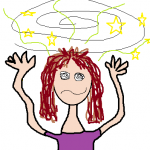 Vertigo is a type of dizziness in which a person has the sensation of spinning movement when stationary. There are many different causes for dizziness including, for example, low blood pressure, low blood sugar, anemia, anxiety, multiple sclerosis and various inner ear problems. Vertigo can be very upsetting and uncomfortable. It is important to determine the cause of dizziness such that an appropriate solution is found.
Vertigo is a type of dizziness in which a person has the sensation of spinning movement when stationary. There are many different causes for dizziness including, for example, low blood pressure, low blood sugar, anemia, anxiety, multiple sclerosis and various inner ear problems. Vertigo can be very upsetting and uncomfortable. It is important to determine the cause of dizziness such that an appropriate solution is found.
There are two types of vertigo that chiropractic care can correct. These are benign paroxysmal positional vertigo (BPPV) and cervicogenic vertigo. By far the most common type of vertigo is BPPV. Chiropractors are trained to differentiate between these types of vertigo using orthopaedic tests and to rule out other potential causes of dizziness (and refer if necessary).
Benign Paroxysmal Positional Vertigo
Benign paroxysmal positional vertigo is a type of vertigo that comes and goes based on head and neck position. When triggered, the dizziness can last a few seconds to a few minutes. Symptoms are commonly triggered by rising from sleep, tilting the head, rolling over in bed, looking up or sudden head motion. This type of vertigo is related to an inner ear problem and the most common cause is a sudden trauma (like a fall).
The inner ear is responsible for balance and motion sense of the head. Within the labyrinth of the inner ear are calcium crystals called otoliths (or “ear rocks”). In BPPV, the otoliths are dislodged from their normal position and migrate into the semicircular canals. The semicircular canals are oriented at roughly ninety degrees to each others. They are filled with fluid called endolymph and also have sensory receptors that are stimulated during head movement to provide motion sense. In BPPV, crystals in the semicircular canals stimulate sensory receptors adversely giving rise to feelings of motion when there are none (or vertigo).
The hallmark for diagnosis of BPPV is a positive Dix-Hallpike maneuver. This test will reliably provoke the vertigo and cause rotary or horizontal nystagmus (involuntary eye movement). It also determines the side of ear involvement.
BPPV can be corrected using either Semmont’s Maneuver or Epley’s Maneuver in which the chiropractor assists the patient in slowly moving their body, head and neck into appropriate positions to encourage the ear rocks to return to the correct location in the inner ear. Following the procedure, the patient is instructed to avoid sudden movements and to sleep for 2 nights in a recumbent position. This procedure has a 90% success rate and often only one treatment is required. If the dizziness returns, the procedure is repeated.
Cervicogenic Vertigo
Cervicogenic vertigo is dizziness that arises from the neck. For example, irritation or injury to the joints, muscles or ligaments of the neck can overstimulate proprioceptors (nerve endings that detect position sense) in the neck giving rise to vertigo. Uncomplicated cervicogenic vertigo can be treated by a chiropractor using muscle work (such as trigger point release or stretching), adjustment and/or physiotherapy modalities depending on examination findings. The goal is to balance the biomechanics of the neck and to promote a more rapid and complete recovery of the damaged tissues.
When to Seek Medical Care
By itself, vertigo is usually benign. However, if a patient experiences symptoms such as double vision, slurred speech, difficulty swallowing, fainting or collapse, numbness, nausea and/or unsteadiness when walking, (even if temporary), they should seek emergency medical care. Patients with progressive worsening symptoms or dizziness accompanied with fever and/or infection should also see a medical doctor.
Dr. Elisabeth Miron